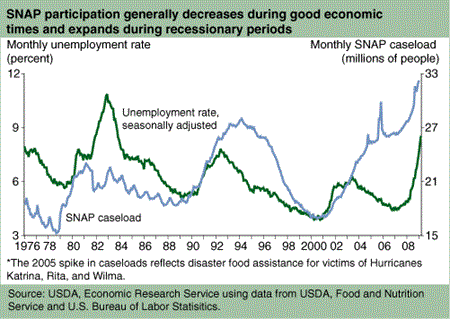Increased SNAP Benefits Provide Countercyclical Boosts

Recessionary conditions led to 33.2 million Americans receiving benefits from the Supplemental Nutrition Assistance Program (SNAP) in March 2009—a record number of participants and 19 percent greater than a year ago. In fiscal year (FY) 2008, SNAP issued $34.6 billion of benefits to an average monthly caseload of 28 million people.
According to ERS estimates, each $1 billion of SNAP benefits generates $1.84 billion of economic activity. Higher unemployment and greater benefit payments per household are expected to increase SNAP benefits by 45 percent in FY 2009 relative to FY 2008. This substantial increase in benefits will increase spending by participants that, in turn, generates more economic activity and jobs.
SNAP, formerly known as the Food Stamp Program, is one of the Federal Government’s primary income-based countercyclical assistance programs. Total benefits issued decrease during good economic times and expand during recessionary periods of job losses and stagnant wages.
The Congressional Budget Office estimates that SNAP benefits in FY 2009 will be $15.4 billion higher than in FY 2008. Higher caseloads will account for two-thirds of the increase. This countercyclical boost will be complemented by an increase in maximum benefit levels. As part of the American Recovery and Reinvestment Act of 2009, Congress raised maximum benefit allotments by 13.6 percent beginning in April 2009. For a four-person family, for instance, maximum benefits jumped from $588 to $668 per month. The increase in maximum benefit levels is estimated to raise total SNAP benefits by $4.8 billion in FY 2009.
ERS researchers used an input-output multiplier model to estimate the impacts of the increased purchasing power provided to needy families through higher SNAP benefit allotments and larger numbers of participants. SNAP participants spend their benefits quickly and fully on food. Spending on nonfood goods expands as well, since SNAP benefits free up some income used for food purchases for spending on nonfood items. This spending is “multiplied” through the economy by a succession of effects: the increased spending by recipient households from the additional SNAP benefits stimulates new production activity; higher production boosts demand for workers and/or hours worked, which increases household income; and higher household income triggers additional spending. The estimated $15.4 billion of additional spending by SNAP participants will provide a $28.3 billion infusion into the economy, helping to preserve and create jobs throughout the economy.
Issues in Food Assistance-Effects of Changes in Food Stamp Expenditures Across the U.S. Economy, by Kenneth Hanson and Elise Golan, USDA, Economic Research Service, August 2002
Supplemental Nutrition Assistance Program (SNAP), by Jordan W. Jones, USDA, Economic Research Service, February 2024


